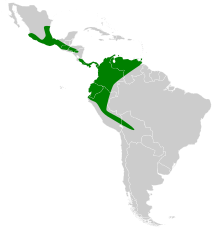Velvety fruit-eating bat
| Velvety fruit-eating bat | |
|---|---|

| |
| In Puntarenas, Costa Rica | |
| Scientific classification | |
| Domain: | Eukaryota |
| Kingdom: | Animalia |
| Phylum: | Chordata |
| Class: | Mammalia |
| Order: | Chiroptera |
| Family: | Phyllostomidae |
| Genus: | Enchisthenes K. Andersen,1906 |
| Species: | E. hartii
|
| Binomial name | |
| Enchisthenes hartii (Thomas,1892)
| |

| |
| Synonyms | |
|
Artibeus hartiiThomas, 1892 | |
Thevelvety fruit-eating bat(Enchisthenes hartii), also known asHart's little fruit bat,is a species ofbatin the familyPhyllostomidae.It isthe only specieswithin the genusEnchisthenes.It is found in Central America, Mexico, the United States, and northern South America.[1]
Taxonomy and etymology[edit]
It wasdescribedas a new species in 1892 by British zoologistOldfield Thomas.Thomas initially placed it in the genusArtibeus,with the scientific nameArtibeus hartii.Theeponymfor thespecies name"hartii"is J. H. Hart, who provided theholotypeto Thomas. Hart was the superintendent of the Botanic Gardens inTrinidad,which is the type locality.[2]
The genusEnchistheneswas described in 1908 by Danish mammalogistKnud Andersen.He noted thatEnchistheneswas closely related toArtibeus,and designatedA. hartiias thetype speciesand the only member of the genus.[3]Though the opinion of the taxonomic validity ofEnchistheneshas varied since its description, it has most recently been recognized as a valid monotypic genus.[4]
Description[edit]
Its fur is nearly black in color, and its face has a few faint lines that are paler in color. It has a forearm length of 36–41 mm (1.4–1.6 in). Individuals weigh 14–18 g (0.49–0.63 oz). Itsdental formulais2.1.2.32.1.2.3for a total of 32 teeth.[4]
Range and habitat[edit]
Its range includesBolivia,Colombia,Costa Rica,Ecuador,El Salvador,Guatemala,Honduras,Mexico,Panama,Peru,Trinidad and Tobago,andVenezuela.There is a single record from theUnited Statesstate ofArizona.[1]
Conservation[edit]
As of 2008, it is evaluated as aleast-concern speciesby theIUCN.[1]
References[edit]
- ^abcdSolari, S. (2018)."Enchisthenes hartii".IUCN Red List of Threatened Species.2018:e.T2130A21996891.doi:10.2305/IUCN.UK.2018-2.RLTS.T2130A21996891.en.Retrieved17 November2021.
- ^Thomas, O. (1892)."XLVIII.—Description of a new bat of the genus Artibeus from Trinidad".The Annals and Magazine of Natural History; Zoology, Botany, and Geology.6.10(59): 409.
- ^Andersen, K. (1908)."A monograph of the chiropteran genera Uroderma, Enchisthenes, and Artibeus".Proceedings of the Zoological Society of London.78(2): 221–224.doi:10.1111/j.1096-3642.1908.tb01844.x.
- ^abCabrales, J. A. (2014). Ceballos, G. (ed.).Mammals of Mexico.JHU Press. pp. 735–736.ISBN978-1421408439.

